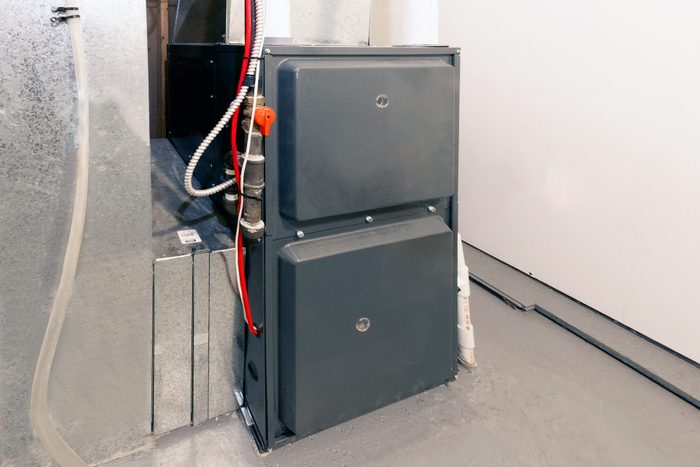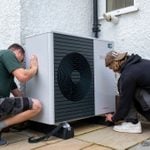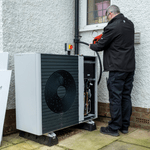A Homeowner’s Guide To Furnaces

Along with the water heater, the furnace is your most important home appliance. Here's a guide to understanding yours and giving it the TLC it needs.
I had a rough initiation into the world of furnace maintenance.
I purchased my first home in 2003, but its gas furnace looked like it was manufactured during the Carter administration. It cost a huge amount of money to operate and habitually switched itself off at inopportune times. We gave it a nickname, Clarice, because we had to visit so frequently to relight the pilot light.
Knowing what I know now, I could probably have squeezed a few more years of service from Clarice. Instead, we went ahead and replaced it. That’s when I started to get smart about furnaces.
Clarice was indeed an inefficient relic and should have been replaced sooner. Modern furnaces must hit an annual fuel utilization efficiency (AFUE) rate of 80 percent, and no repair could bring Clarice to those standards. These days, gas furnaces are even more efficient — some close to 100 percent — and they don’t fill the atmosphere with pollutants.
If you’re moving into your first home, say goodbye to the halcyon days of complaining to the landlord when your furnace doesn’t work. It’s worth taking the time to know your furnace better. That way you can give it the TLC it needs, and tell the difference between repairs you can do yourself and those that need professional attention.
On This Page
What Is a Furnace?
A furnace is an appliance that generates heat — usually enough to supply an entire building. It does this by burning a fuel or passing electricity through resistive heating elements.
A furnace isn’t the same as a heat pump, which transfers heat from outdoors into the building. If your central heat system doesn’t include an air conditioner, and it’s connected to an outdoor unit with a fan, you have a heat pump that requires different maintenance than a furnace.
How Does a Furnace Work?
A furnace works in conjunction with a room thermostat and an electronic control panel.
When the thermostat detects the room temperature has fallen below its preset minimum, it sends a signal to the control system to switch on the heat. A blower housed in a structure called the air handler also switches on and circulates warm air through the ductwork system.
Many homeowners find furnaces intimidating because of complicated control system. Furnaces contain safety sensors, switches and high-limit fuses that wear out or malfunction periodically. While homeowners can address some of these issues, diagnosis and repair are usually best left to a qualified technician.
Types of Furnaces
Virtually all modern furnaces are housed in rectangular metal boxes and classified by the type of fuel used. Most furnaces operate in conjunction with an air handler that connects to the supply and the return ducts. That’s where the blower is located. Air handlers may be separate from the furnace.
Electric
Electric furnaces feature a high-voltage heating element. The blower draws air into the heating element, then circulates it back through the ducts. Electric furnaces have no combustion chamber and don’t require a flue.
Standard-efficiency natural gas/propane
These require a combustion chamber and a flue. Heat created in the sealed combustion chamber is transferred to the blower through a thermally conductive plate called a heat exchanger. Combustion gases exhaust through the flue, which extends through the roof into the open air.
High-efficiency natural gas/propane
Also known as condensing furnaces, these have an AFUE greater than 90.
Instead of a flue, they utilize a secondary heat exchanger, basically a set of coils where combustion gases cool and condense. Condensation produces heat, which combines with the heat from the primary exchanger and circulates via the blower. The byproduct, known as condensate, is carried away by a PVC drain that extends through the wall.
Heating oil
Like standard efficiency gas furnaces, oil-burning furnaces also feature a combustion chamber, heat exchanger and exhaust flue. A fuel pump sprays oil into the combustion chamber. Oil-burning furnaces are popular in regions of the Northern U.S. and Canada where fuel oil may be cheaper than gas.
How Long Does a Furnace Last?
Electric furnaces tend to last longer that gas or oil furnaces (up to 20 years) because they contain fewer parts and no combustion chamber. A gas or oil furnace can last for 15 years. It isn’t unusual for homeowners to keep their furnaces longer than that, but performance usually suffers.
How To Maintain a Furnace
The top maintenance task for homeowners with a furnace is replacing the air filters regularly. There’s one in the air handler and usually one in the main return register in the house. This should be done every three months of continuous operation to maintain furnace performance and keep the indoor air free of contaminants.
Other important maintenance tasks include:
- Clean the blower: At least once a year, turn the furnace off, let it cool, open the air handler and brush dust off the blower fins and the motor. If you notice squeaking or grinding sounds when the blower is running, spray some lubricant along the axis where the fins rotate.
- Dust off the heat exchanger: Dust inhibits heat flow. Wipe it off with a dry rag.
- Inspect the ducts: Look for holes, tears or gaps in the ductwork and patch them with aluminum foil tape (not duct tape).
If you own a gas furnace, do these additional tasks:
- Check the ignition system and flame condition: Remove the front cover and have someone turn on the furnace while you watch to make sure the ignition system is working properly. All the flames should be blue. If any are orange or yellow, or they sputter, the burners need to be professionally cleaned.
- Clean the flame sensor: Once a year, remove the flame sensor following the instructions in your owner’s manual, and clean it with sandpaper. Over time, it tends to be covered in soot that it can’t detect a flame and shuts down the furnace.
Furnace Troubleshooting
Furnace malfunctions usually mean something is wrong with the control circuitry or the thermostat settings. Always check the thermostat before assuming anything else is wrong.
It’s also important to check the circuit breaker that controls the furnace to make sure it hasn’t tripped. If your gas furnace shuts down frequently, try cleaning the flame sensor. Other problems are best left to pros for diagnosis and repair.
Note: If you smell gas in the furnace room, turn off the furnace and call an HVAC technician immediately.
How Much Does It Cost to Replace a Furnace?
Depending on the type of furnace, it can run from $3,000 to $7,600, including labor and permits. Electric furnaces are easiest to replace and cost the least, while high-efficiency gas furnaces cost the most.
Furnace Alternatives
A heat pump is a viable alternative to a furnace in many parts of North America except for those with extremely cold temperatures. Contemporary models can heat a home when the outdoor temperature is minus-10 degrees. Beginning in 2023, the federal government will offer incentives for homeowners looking to install a new one.
A wood stove or pellet stove can efficiently heat a home with an open floor plan. A hydronic heat system with a central boiler and radiators, baseboard heaters or in-floor pipes spread throughout the house is an increasingly popular heating option.



